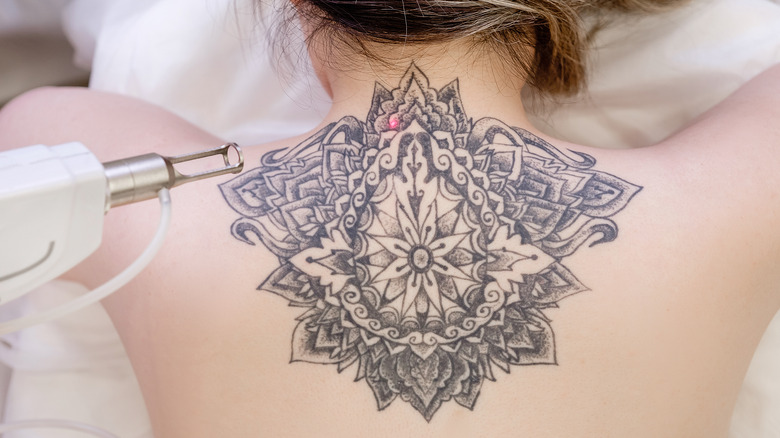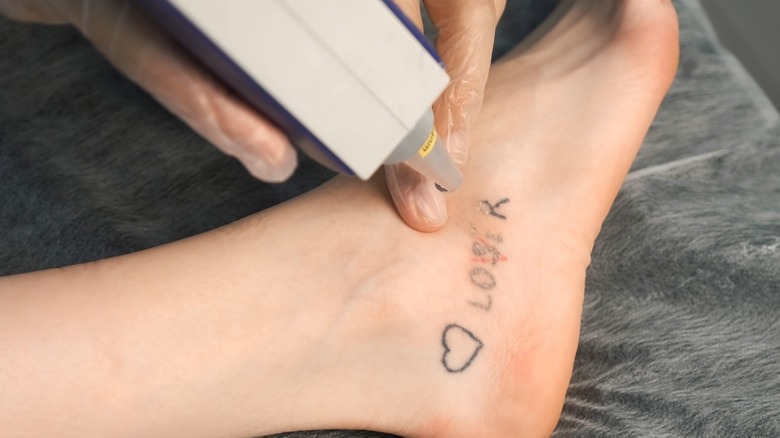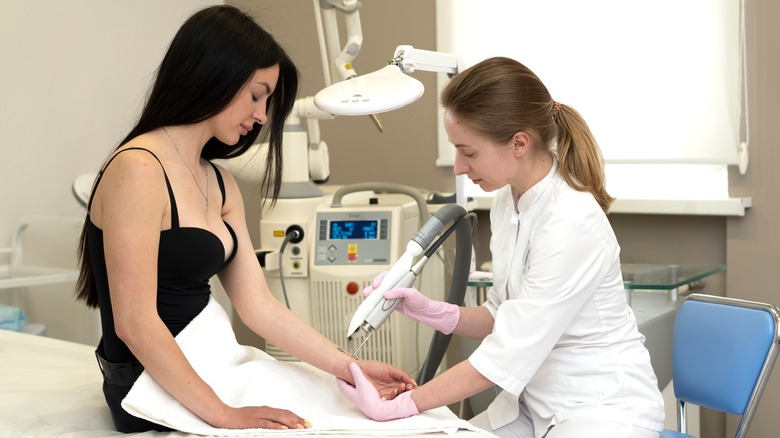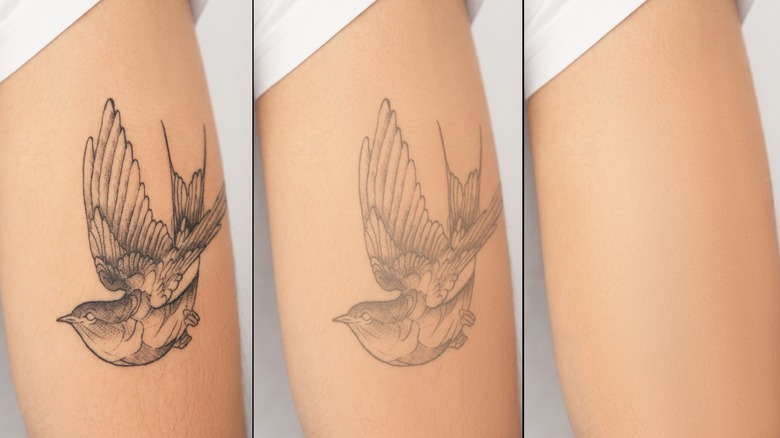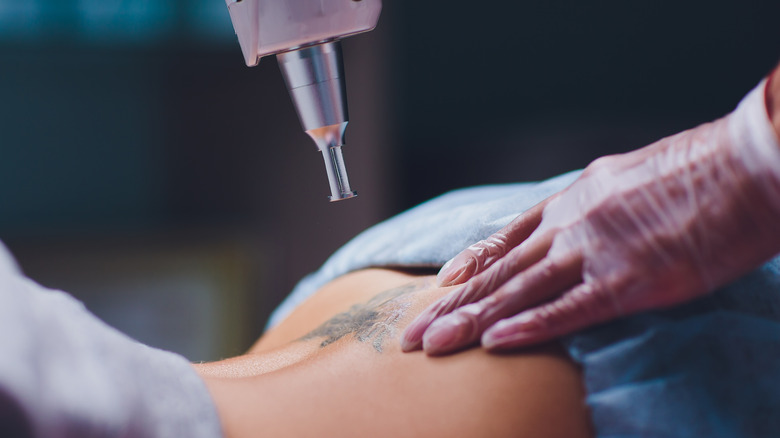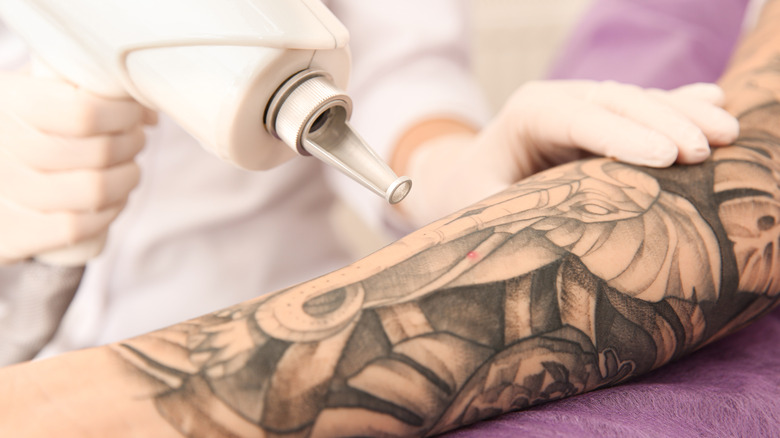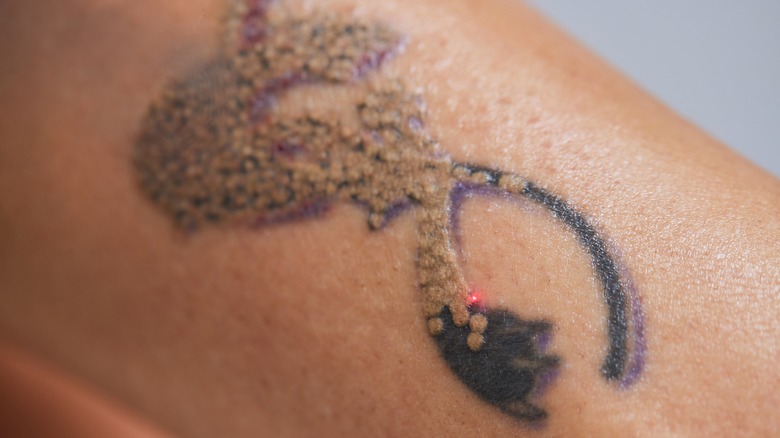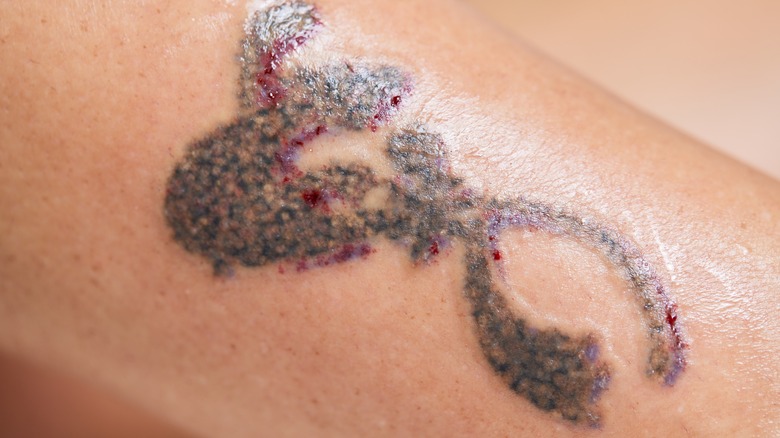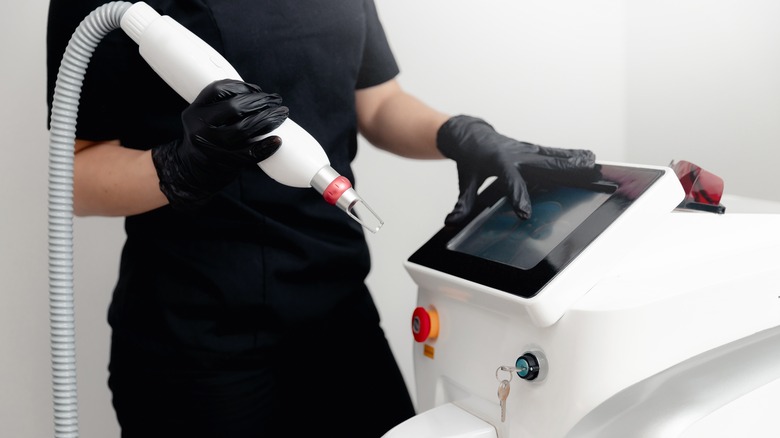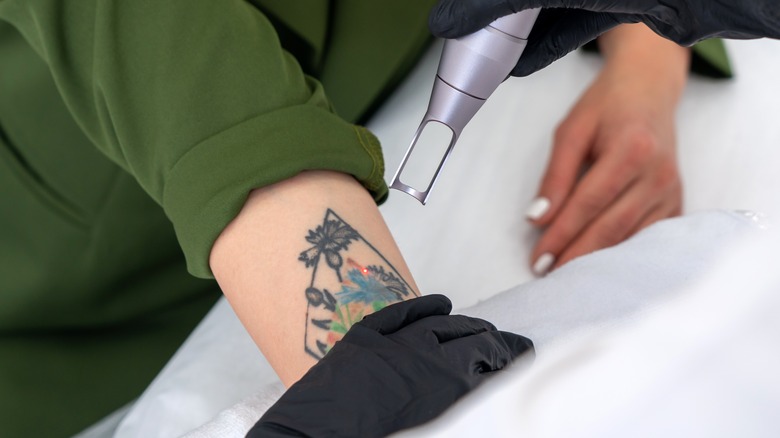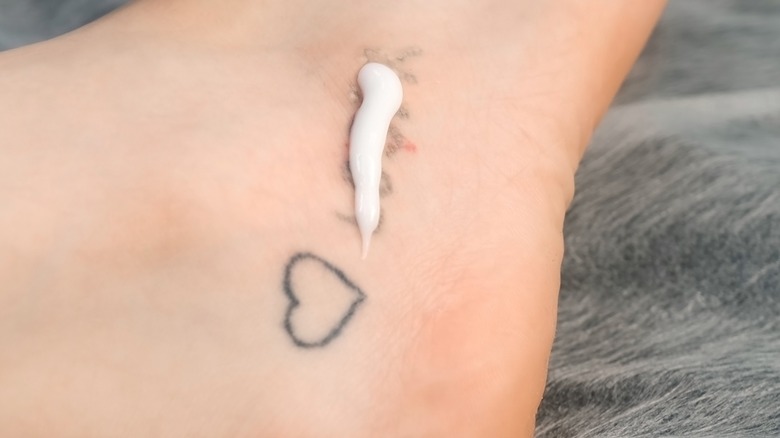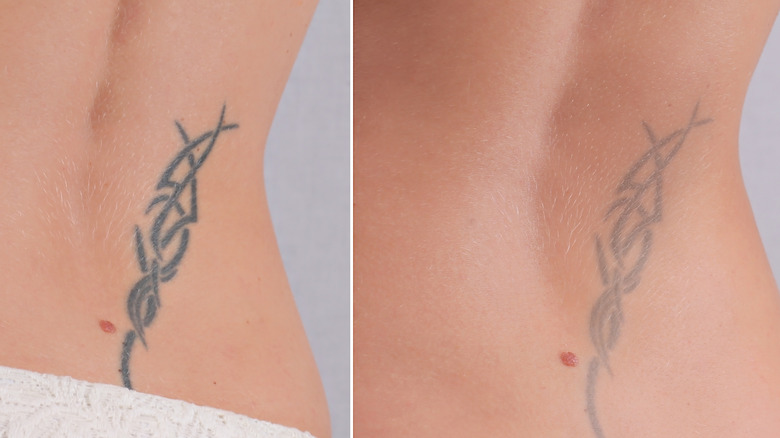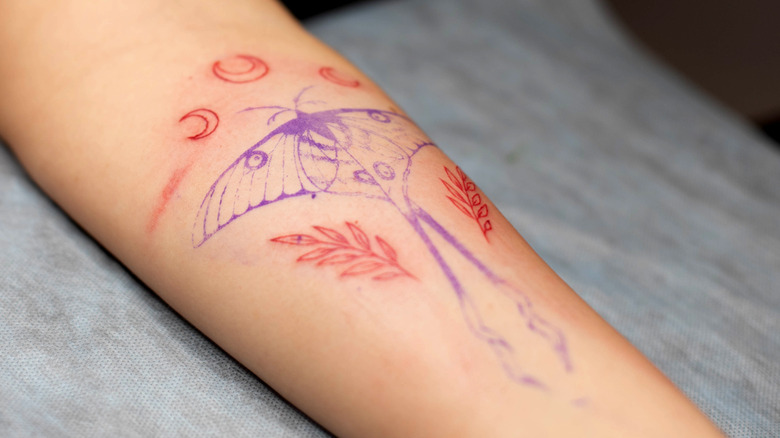Everything You Need To Know Before Getting A Tattoo Removed
Are you no longer loving that butterfly tattoo you got in high school on the small of your back as much as you once did? Or feel like those initials you inked on your wrist in honor of an ex are definitely not as cute now that you've broken up? Maybe you got a tattoo that isn't quite as high quality as you thought it would be, or perhaps you've simply grown tired of your body art over the years. Regardless of the reason for wanting to get a regrettable tattoo removed, the ability to do so is easier now than ever before, thanks to laser tattoo removal.
But while many people know a lot about what getting a tattoo entails, not as many are aware of what you need to know before getting that tattoo removed. Many of us have heard that the process of removing a tattoo can be painful and it requires more than one visit before the tattoo is permanently erased. But there are lots of other unknowns about cost, accessibility, side effects, and long-term repercussions of tattoo removal that people aren't as familiar with. If you've been thinking about laser tattoo removal but have some questions about the procedure, we break down everything you need to know.
What is laser tattoo removal?
According to WebMD, lasers work to remove your existing body art by using a high-intensity light beam to break up the pigment colors in the ink in your tattoo. Certain lasers are used on certain colors, but black absorbs all wavelengths, making it the easiest color to remove. Some facilities will use different lasers to target different areas of your tattoo, depending on the color of the inks used.
When the laser, which produces pulses of light energy as opposed to one continuous stream of light, penetrates the skin, those pulses are absorbed by the ink in your tattoo, according to New Look Laser College. The ink particles then heat up to the point that they break into small pieces that the body's immune system naturally flushes away in the weeks following treatment. This ultimately lightens the appearance of the tattoo. After multiple sessions, the tattoo will continue to fade until it is eventually gone.
How to find a reputable laser tattoo removal facility
If you're looking to have your tattoo removed in the safest and most efficient way possible, you'll want to ensure that a professional such as a dermatologist, plastic surgeon, or certified tattoo removal practician performs the procedure. While there are at-home tattoo removal products available, including tattoo removal creams, they don't come highly recommended, according to Vanguard Dermatology.
Someone who is board certified will give you a complete and thorough consultation prior to your procedure in order to set realistic expectations about not only how long it will take to completely remove your tattoo, but all of the costs involved. They can also ensure that you have no current skin conditions that may impact your overall result and will take precautions to ensure that your skin won't be burned or scarred in the removal process.
It is also recommended to do some of your own research in advance about which lasers may work best for your tattoo and skin type, so you can seek out providers who will have the right laser for your skin.
How many sessions will it take?
If you've gotten to the point where you're ready to finally ready to undergo laser tattoo removal, you're probably going to be very anxious about getting rid of that unsightly ink as soon as possible. Sadly, your tattoo is not going to disappear after your first laser treatment. There are a number of factors that can impact how long it will take to remove a tattoo, such as the size of your tattoo, the colors used in your tattoo, how old your tattoo is, and whether it was an amateur job or done by a professional (via Fade).
Tattoo removal specialist Bethany Cirlin explained to Glamour that the average tattoo removal can take around two and a half years. "Laser treatments should be scheduled three months apart from one another so you get the most out of each treatment. This allows your body to break down as much of the tattoo as it can while also giving your body the opportunity to heal completely before your next session," she said.
On average, full removal can take anywhere from 10-12 sessions, according to Removery. However, if it's any consolation, each session is typically pretty short — clocking in at less than 30 minutes.
Will my tattoo be 100% gone?
While surgical excision is the only way to fully guarantee a 100% removal of your tattoo, according to Removery, advances in lasers have made it so that it's possible to get near-perfect results without having to go under the knife. Lasers can remove most, if not all, of a tattoo but results can vary from person to person, according to Goodbye Tattoos. Believe it or not, darker colors like black and red are easier for the lasers to remove than lighter colors like yellow, blue and green because the laser is naturally drawn to the darker colors.
The older a tattoo is the easier it is to erase, thanks in part to the natural fading that occurs over time. Interestingly, tattoos located closer to the heart are easier to remove due to higher blood circulation in that area of the body (via Goodbye Tattoos). Most removal experts state that with advances in lasers and continued advanced training for providers, most can completely eliminate all colors of ink in any tattoo. The only difference is the amount of time it takes.
Does laser tattoo removal hurt?
The one thing most people have heard about laser tattoo removal, regardless of whether they have a tattoo or not, is how much it hurts! Some even say the removal hurts more than the actual process of getting the tattoo. This can sometimes act as a deterrent to those who really want to get rid of some bad ink but are worried about the pain involved in the process.
Board-certified dermatologist Dr. Jeffrey Fromowitz explained to Allure that while the process can be painful and uncomfortable, there are ways to try to make the patient more at ease. "In my practice, we use several methods to decrease discomfort, including external forced air chilling of the skin surface and topical RS numbing gels applied 30 to 60 minutes before treatment," he said. "For larger tattoos, we use a tumescent injection of lidocaine."
Again, size, color, and location of the tattoo are all contributing factors as to how painful it will be to remove, but comfort is another reason you want to choose a board-certified practitioner to remove your tattoo. It's worth asking during your consultation what methods to help ease discomfort and pain will be offered.
What are the risks?
As with any medical procedure, tattoo removal isn't without its own risks, and if you're considering this procedure you should be aware of them. According to Advanced Aesthetic & Laser Surgery, some of the risks associated with laser tattoo removal include infection, bleeding, and scarring.
It's also possible for ink can change color after being hit by the laser, or you may see a change in your skin's natural pigment. The removal process may also result in hair removal near the site of the tattoo removal, and blistering can occur. In some rare cases, the removal can trigger an immune system reaction. Additionally, everyone should wear safety glasses during the procedure to prevent any risk of eye injuries as well.
Knowing all the risks involved and help you to make an educated decision on whether or not moving forward with the procedure is the best choice for you.
What will my skin look like after each session?
Knowing that it can take multiple sessions to remove a tattoo, it's absolutely understandable for someone to be curious about what the tattoo will look like as it undergoes each stage of the removal process. According to the Dermatology and Skin Cancer Institute, patients may feel a sensation similar to that of a sunburn on the treated area after each session. There may also be some sensitivity in that area as well as scabbing.
You will actually see some significant fading after your first session, especially around the outlines as well as some uneven fading of the actual tattoo, according to Removery. At each subsequent session, your tattoo will continue to fade even more. The good news is that if you're just looking to fade a tattoo enough to cover it with new ink, you may only need as few as three sessions. Regardless of your goals, with each session, you will see more and more improvement.
How much does it cost?
Laser tattoo removal isn't cheap, but the final cost is still dependent on the size and color of your tattoo and how many sessions you'll need to complete the full removal. Just like how tattoos vary in cost depending on who does it, how long it takes, how large it is, and how intricate the design is, those same factors will impact the final cost of your tattoo removal.
According to the American Association of Plastic Surgeons, the average cost of a laser tattoo removal session is $423. There are many different factors to consider when thinking of the cost of tattoo removal including a surgeon's fee if you opt for surgical removal, the fee of the laser practitioner, the cost of the actual procedure, any medical tests you may need before undergoing the removal, as well as any possible medications that are required for after the removal.
However, if you have a large, detailed tattoo that's made up of many colors, it could cost as much as $4,000 to remove. So while removal is possible, it can get pricey.
Partial tattoo removal is possible
So, what if you have a tattoo you love but on a whim decided to ink an old flame's name near it — but now you aren't together anymore? Or maybe you're in a situation where there are some aspects of your tattoo that you don't love while the rest is perfection?
The good news is that laser tattoo removal can help you modify your tattoo. Complete removal is not necessary. According to Fairview Laser Clinic Inc, the quality of the outcome after modifying your tattoo is dependent on the skill of the operator, the color that is being removed, the intensity of said color, and how complex the tattoo is in the area you want it removed from.
If the part of your tattoo you no longer want can't be fully removed successfully, a licensed operator can typically fade it enough so that you can get a new tattoo to cover it up.
Avoid the sun after your laser session
You'll need to be very protective of your skin after your laser session to remove that unwanted tattoo. You should ideally wait at least a month after your final laser session before sunbathing or even spending any significant amount of time in the sun, according to Inkaway Laser Tattoo Removal. Limiting sun exposure to around 10 minutes each day is a good recommendation to folllow. The sun could cause your skin to burn quickly which could then lead to scarring.
You should also avoid tanning salons for at least four weeks after your treatment because of the risk of discoloration to the treated area. Even topical at-home tanning solutions aren't advised while you're recovering from the tattoo removal because some of the ingredients in the sunless tanning products can potentially react with the laser. The experts at Inkaway Laser Tattoo Removal suggest waiting two weeks after you apply any sunless tanning product to book your laser appointment and two weeks after your appointment to apply any new product.
How to care for your skin after a session
We know that avoiding the sun is key when caring for your skin after a laser tattoo removal session, but there are other ways you'll need to protect it also. According to Laser All, you should cover the affected area with a topical antibiotic ointment and a sterile bandage for about three days after your appointment. You'll want to keep the area clean and dry and free of any other lotions or creams during this time, and you should also avoid applying any makeup to the affected area as well.
After those three days have passed you can remove the bandage, but you still want to keep the area clean and dry. Using topical solutions like Vaseline, Aquaphor, or hydrocortisone cream to keep the area moisturized as it heals is recommended. Vitamin E cream can also help in the healing process. Again, protecting your skin from the sun after each session is particularly important, so sunscreen should always be applied if you're going to be outside for any extended period of time.
How long does it take to heal?
While there is no cut and dry amount of time that your tattoo removal will take to heal, it typically can take as long as two months for full healing to happen, according to Rochester Tattoo Removal. You may see some initial blistering or skin irritation after your laser session that will go away in about a week to two weeks, but full healing can take anywhere from 6-8 weeks.
Your skin may actually turn white for a few minutes after the contact with the laser. This is known as 'frosting' and is quite common. Afterward, your skin may blister and scab but those should heal within a couple of weeks. As tempting as it may be, it's important not to pop any blisters that form or pick at the scabs, so you can allow the skin to fully heal without risking any permanent marking or scarring. If you do have a blister that oozes or weeps, you should cover it with a sterile bandage that you change regularly, until the blister heals.
How can I prepare my skin for tattoo removal?
Although laser tattoo removal can seem pretty straightforward, there are some things you can do to help better prepare yourself and your body for the procedure. You may not realize it, but it's important to eat well and hydrate before your appointment.
According to Youbaby Skin Spa, due to the discomfort associated with this procedure, not being properly hydrated and having an empty stomach can lead to feelings of dizziness and lightheadedness. It is also recommended to quit smoking entirely prior to your appointment, or at the very least, cut back on the amount you smoke each day. Smoking slows down your body's ability to heal which is not preferable after laser tattoo removal. To lessen discomfort during the procedure, you can take also Tylenol or acetaminophen before your appointment, but avoid taking Advil or any aspirin product because it could cause bruising.
Getting a new tattoo over one that was removed
Whether you're looking to fade an existing tattoo enough to cover it with something different, or hoping to completely remove a tattoo and start with a clean slate, there are some things that will dictate whether or not you can get a new tattoo where you had a previous one removed.
According to Naama, your ability to do this will depend on the condition of your skin after your removal and healing time is complete. If you've experienced any scarring or discoloration to the skin it may affect the quality of a new tattoo if it is placed in the same spot. However, because laser tattoo removal technology has made huge advancements over the years, it's becoming all the more possible to tattoo over any area that has been previously treated. If your goal is to cover an existing tattoo or have new ink work done in place of previous body art, having your tattoo removed using the highest level of technology available is advisable as it is the best way to minimize any skin damage.
